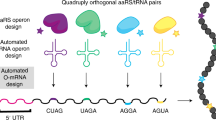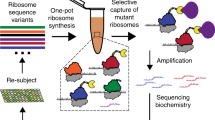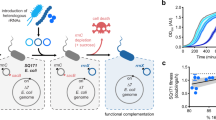Abstract
In vivo incorporation of unnatural amino acids by amber codon suppression is limited by release factor-1–mediated peptide chain termination. Orthogonal ribosome-mRNA pairs function in parallel with, but independent of, natural ribosomes and mRNAs. Here we show that an evolved orthogonal ribosome (ribo-X) improves tRNACUA-dependent decoding of amber codons placed in orthogonal mRNA. By combining ribo-X, orthogonal mRNAs and orthogonal aminoacyl-tRNA synthetase/tRNA pairs in Escherichia coli, we increase the efficiency of site-specific unnatural amino acid incorporation from ∼ 20% to >60% on a single amber codon and from <1% to >20% on two amber codons. We hypothesize that these increases result from a decreased functional interaction of the orthogonal ribosome with release factor-1. This technology should minimize the functional and phenotypic effects of truncated proteins in experiments that use unnatural amino acid incorporation to probe protein function in vivo.
This is a preview of subscription content, access via your institution
Access options
Subscribe to this journal
Receive 12 print issues and online access
$209.00 per year
only $17.42 per issue
Buy this article
- Purchase on Springer Link
- Instant access to full article PDF
Prices may be subject to local taxes which are calculated during checkout





Similar content being viewed by others
References
Xie, J. & Schultz, P.G. A chemical toolkit for proteins–an expanded genetic code. Nat. Rev. Mol. Cell Biol. 7, 775–782 (2006).
Furter, R. Expansion of the genetic code: site-directed p-fluoro-phenylalanine incorporation in Escherichia coli. Protein Sci. 7, 419–426 (1998).
Wang, L., Brock, A., Herberich, B. & Schultz, P.G. Expanding the genetic code of Escherichia coli. Science 292, 498–500 (2001).
Sakamoto, K. et al. Site-specific incorporation of an unnatural amino acid into proteins in mammalian cells. Nucleic Acids Res. 30, 4692–4699 (2002).
Chin, J.W. et al. An expanded eukaryotic genetic code. Science 301, 964–967 (2003).
Kohrer, C., Xie, L., Kellerer, S., Varshney, U. & RajBhandary, U.L. Import of amber and ochre suppressor tRNAs into mammalian cells: a general approach to site-specific insertion of amino acid analogues into proteins. Proc. Natl. Acad. Sci. USA 98, 14310–14315 (2001).
Kohrer, C., Yoo, J.H., Bennett, M., Schaack, J. & RajBhandary, U.L. A possible approach to site-specific insertion of two different unnatural amino acids into proteins in mammalian cells via nonsense suppression. Chem. Biol. 10, 1095–1102 (2003).
Lummis, S.C. et al. Cis-trans isomerization at a proline opens the pore of a neurotransmitter-gated ion channel. Nature 438, 248–252 (2005).
Nowak, M.W. et al. In vivo incorporation of unnatural amino acids into ion channels in Xenopus oocyte expression system. Methods Enzymol. 293, 504–529 (1998).
Noren, C.J., Anthony-Cahill, S.J., Griffith, M.C. & Schultz, P.G. A general method for site-specific incorporation of unnatural amino acids into proteins. Science 244, 182–188 (1989).
Bain, J.D., Glabe, C.G., Dix, T.A., Chamerlin, A.R. & Diala, E.S. Biosynthetic site-specific incorporation of non-natural amino acids into a polypeptide. J. Am. Chem. Soc. 111, 8013–8014 (1989).
Heckler, T.G. et al. T4 RNA ligase mediated preparation of novel “chemically misacylated” tRNAPheS. Biochemistry 23, 1468–1473 (1984).
Hohsaka, T., Ashizuka, Y., Murakami, H. & Sisido, M. Incorporation of Non-natural amino acids into streptavidin through in vitro frame shift suppression. J. Am. Chem. Soc. 118, 9778–9779 (1996).
Murakami, H., Ohta, A., Goto, Y., Sako, Y. & Suga, H. Flexizyme as a versatile tRNA acylation catalyst and the application for translation. Nucleic Acids Symp. Ser. (Oxf.) no. 50, 35–36 (2006).
Capecchi, M.R. Polypeptide chain termination in vitro: isolation of a release factor. Proc. Natl. Acad. Sci. USA 58, 1144–1151 (1967).
Caskey, C.T., Tompkins, R., Scolnick, E., Caryk, T. & Nirenberg, M. Sequential translation of trinucleotide codons for the initiation and termination of protein synthesis. Science 162, 135–138 (1968).
Scolnick, E., Tompkins, R., Caskey, T. & Nirenberg, M. Release factors differing in specificity for terminator codons. Proc. Natl. Acad. Sci. USA 61, 768–774 (1968).
Dougherty, D.A. Unnatural amino acids as probes of protein structure and function. Curr. Opin. Chem. Biol. 4, 645–652 (2000).
Mori, H. & Ito, K. Different modes of SecY-SecA interactions revealed by site-directed in vivo photo-cross-linking. Proc. Natl. Acad. Sci. USA (2006).
Chin, J.W. & Schultz, P.G. In vivo photocrosslinking with unnatural amino Acid mutagenesis. ChemBioChem 3, 1135–1137 (2002).
Short, G.F., III, Golovine, S.Y. & Hecht, S.M. Effects of release factor 1 on in vitro protein translation and the elaboration of proteins containing unnatural amino acids. Biochemistry 38, 8808–8819 (1999).
Kleina, L.G., Masson, J.M., Normanly, J., Abelson, J. & Miller, J.H. Construction of Escherichia coli amber suppressor tRNA genes. II. Synthesis of additional tRNA genes and improvement of suppressor efficiency. J. Mol. Biol. 213, 705–717 (1990).
Ryu, Y. & Schultz, P.G. Efficient incorporation of unnatural amino acids into proteins in Escherichia coli. Nat. Methods 3, 263–265 (2006).
Blattner, F.R. et al. The complete genome sequence of Escherichia coli K-12. Science 277, 1453–1474 (1997).
Rackham, O. & Chin, J.W. A network of orthogonal ribosome • mRNA pairs. Nat. Chem. Biol. 1, 159–166 (2005).
Hui, A. & de Boer, H.A. Specialized ribosome system: preferential translation of a single mRNA species by a subpopulation of mutated ribosomes in Escherichia coli. Proc. Natl. Acad. Sci. USA 84, 4762–4766 (1987).
Triman, K.L., Peister, A. & Goel, R.A. Expanded versions of the 16S and 23S ribosomal RNA mutation databases (16SMDBexp and 23SMDBexp). Nucleic Acids Res. 26, 280–284 (1998).
Schuwirth, B.S. et al. Structures of the bacterial ribosome at 3.5 A resolution. Science 310, 827–834 (2005).
Korostelev, A., Trakhanov, S., Laurberg, M. & Noller, H.F. Crystal structure of a 70S ribosome-tRNA complex reveals functional interactions and rearrangements. Cell 126, 1065–1077 (2006).
Selmer, M. et al. Structure of the 70S ribosome complexed with mRNA and tRNA. Science 313, 1935–1942 (2006).
Carter, A.P. et al. Functional insights from the structure of the 30S ribosomal subunit and its interactions with antibiotics. Nature 407, 340–348 (2000).
Petry, S. et al. Crystal structures of the ribosome in complex with release factors RF1 and RF2 bound to a cognate stop codon. Cell 123, 1255–1266 (2005).
Magliery, T.J., Anderson, J.C. & Schultz, P.G. Expanding the genetic code: selection of efficient suppressors of four-base codons and identification of “shifty” four-base codons with a library approach in Escherichia coli. J. Mol. Biol. 307, 755–769 (2001).
Cannone, J.J. et al. The comparative RNA web (CRW) site: an online database of comparative sequence and structure information for ribosomal, intron, and other RNAs. BMC Bioinformatics 3, 2 (2002).
Datta, K. & Majumdar, M.K. A method for assay of chloramphenicol acetyltransferase from crude cell extract. Microbiologica 8, 73–77 (1985).
Rice, J.B., Libby, R.T. & Reeve, J.N. Mistranslation of the mRNA encoding bacteriophage T7 0.3 protein. J. Biol. Chem. 259, 6505–6510 (1984).
Kramer, E.B. & Farabaugh, P.J. The frequency of translational misreading errors in E. coli is largely determined by tRNA competition. RNA 13, 87–96 (2007).
Kauer, J.C., Erickson-Viitanen, S., Wolfe, H.R., Jr. & DeGrado, W.F. p-Benzoyl-L-phenylalanine, a new photoreactive amino acid. Photolabeling of calmodulin with a synthetic calmodulin-binding peptide. J. Biol. Chem. 261, 10695–10700 (1986).
Chin, J.W., Martin, A.B., King, D.S., Wang, L. & Schultz, P.G. Addition of a photocrosslinking amino acid to the genetic code of Escherichia coli. Proc. Natl. Acad. Sci. USA 99, 11020–11024 (2002).
Hino, N. et al. Protein photo-cross-linking in mammalian cells by site-specific incorporation of a photoreactive amino acid. Nat. Methods 2, 201–206 (2005).
Schlieker, C. et al. Substrate recognition by the AAA+ chaperone ClpB. Nat. Struct. Mol. Biol. 11, 607–615 (2004).
Weibezahn, J. et al. Thermotolerance requires refolding of aggregated proteins by substrate translocation through the central pore of ClpB. Cell 119, 653–665 (2004).
Steer, B.A. & Schimmel, P. Major anticodon-binding region missing from an archaebacterial tRNA synthetase. J. Biol. Chem. 274, 35601–35606 (1999).
Bossi, L. Context effects: translation of UAG codon by suppressor tRNA is affected by the sequence following UAG in the message. J. Mol. Biol. 164, 73–87 (1983).
Youngman, E.M., Cochella, L., Brunelle, J.L., He, S. & Green, R. Two distinct conformations of the conserved RNA-rich decoding center of the small ribosomal subunit are recognized by tRNAs and release factors. Cold Spring Harb. Symp. Quant. Biol. 71, 545–549 (2006).
Stadtman, T.C. Selenocysteine. Annu. Rev. Biochem. 65, 83–100 (1996).
Crick, F.H. Codon–anticodon pairing: the wobble hypothesis. J. Mol. Biol. 19, 548–555 (1966).
Rackham, O. & Chin, J.W. Cellular logic with orthogonal ribosomes. J. Am. Chem. Soc. 127, 17584–17585 (2005).
Murray, I.A. & Shaw, W.V. O-Acetyltransferases for chloramphenicol and other natural products. Antimicrob. Agents Chemother. 41, 1–6 (1997).
Lutz, R. & Bujard, H. Independent and tight regulation of transcriptional units in Escherichia coli via the LacR/O, the TetR/O and AraC/I1–I2 regulatory elements. Nucleic Acids Res. 25, 1203–1210 (1997).
Acknowledgements
J.W.C. is an EMBO Young Investigator. K.W. is grateful for a Medical Research Council-Laboratory of Molecular Biology (MRC-LMB) Cambridge Scholarship, an Honorary External Research Studentship from Trinity College, Cambridge, and an Overseas Research Studentship Award. H.N. is an MRC Career Development Fellow. We are grateful to O. Barrett and W. An for sharing unpublished materials and assisting in early stages of this project. We are grateful to M. Babu for extracting E. coli amber codon usage, P.G. Schultz (TSRI) for the pSUP Bpa vector. This work was funded by The Medical Research Council.
Author information
Authors and Affiliations
Corresponding author
Ethics declarations
Competing interests
The authors declare no competing financial interests.
Supplementary information
Supplementary Fig. 1
The anticodon stem loops of the tRNAs used. (PDF 40 kb)
Supplementary Fig. 2
The context of UAGA and UAG selector codons in cat reporter genes. (PDF 43 kb)
Supplementary Fig. 3
The linker region of the gst-malE expression construct. (PDF 25 kb)
Supplementary Fig. 4
35S misincorporation in GST-MBP. (PDF 796 kb)
Supplementary Fig. 5
The ribosome dependence of O-DLR derived Renilla luciferase (O-R-luc) activity. (PDF 108 kb)
Supplementary Fig. 6
The Ribo-X mediated enhanced unnatural amino acid incorporation efficiency is robust in minimal medium. (PDF 297 kb)
Supplementary Table 1
528/36 16S rDNA Libraries Construction. (PDF 32 kb)
Supplementary Table 2
Primers Used. (PDF 48 kb)
Rights and permissions
About this article
Cite this article
Wang, K., Neumann, H., Peak-Chew, S. et al. Evolved orthogonal ribosomes enhance the efficiency of synthetic genetic code expansion. Nat Biotechnol 25, 770–777 (2007). https://doi.org/10.1038/nbt1314
Received:
Accepted:
Published:
Issue Date:
DOI: https://doi.org/10.1038/nbt1314
This article is cited by
-
Adding α,α-disubstituted and β-linked monomers to the genetic code of an organism
Nature (2024)
-
Photoswitching fingerprint analysis bypasses the 10-nm resolution barrier
Nature Methods (2022)
-
Systematic molecular evolution enables robust biomolecule discovery
Nature Methods (2022)
-
Three-dimensional structure-guided evolution of a ribosome with tethered subunits
Nature Chemical Biology (2022)
-
Ribosome selectivity and nascent chain context in modulating the incorporation of fluorescent non-canonical amino acid into proteins
Scientific Reports (2022)



